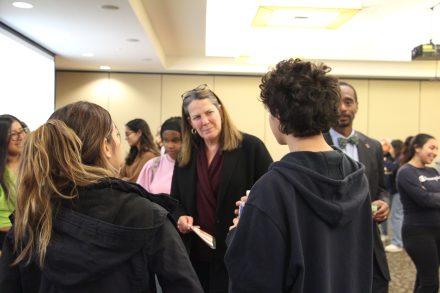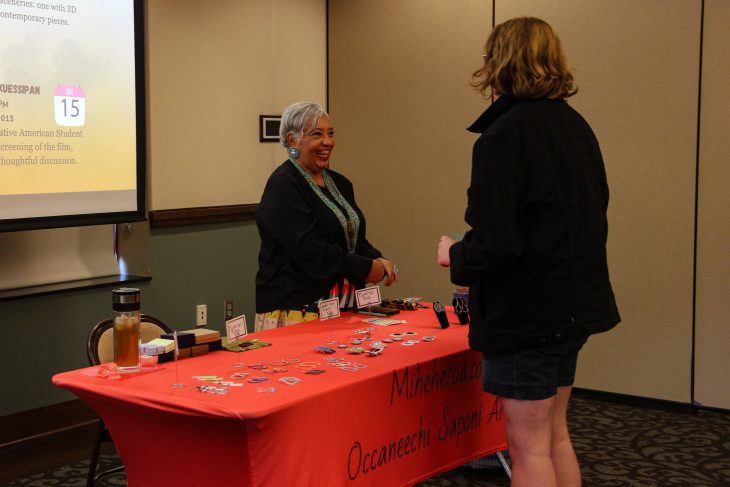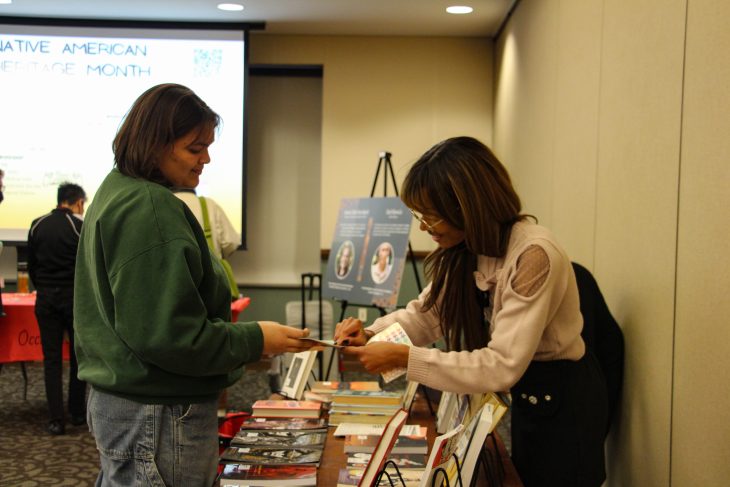Elon kicked off Native American Heritage Month with a celebration in Lakeside that included a display by and indigenous artist, food from a local indigenous caterer and a chance to win various prizes.
Participants received a pamphlet about Native American Heritage Month (NAHM) with information about upcoming events, indigenous people in North Carolina, local organizations and more. Included was the official land acknowledgement of the Occaneechi Band of the Saponi Nation, which has historic ties to the land where Elon is located. To win prizes, participants must follow the “pathways” located in the NAHM pamphlet. The “pathways” were an opportunity to learn more about indigeneity, intersections and identification.
President Connie Ledoux Book said that the event offered an opportunity for education as well as celebration.

“I wanted to understand more about the presence and indigenous associations here in the area,” Book said. “The places that we can learn, the connections we could make.”
At various tables set up around the room, participants could explore indigeneity, intersections and identification by engaging with members of different communities and organizations and gathering information to take with them.
Members of the Black Student Union offered insight into the connections between Native Americans and formerly enslaved people at their table. “Most of the slaves were brought here and didn’t have any space to go to after they got free or found their freedom by running away. So, a lot of them were accepted by Native Americans because they were being treated the same respectively,” said Steven Mmari ‘24.
Other tables represented groups including the Asian-Pacific Student Association, Latinx-Hispanic Union and the Gender & LGBTQIA Center (GLC). Representatives at the GLC table offered participants the opportunity to learn about the gender concept of Two Spirit.
“Spirit is really an umbrella term for someone that is native and carries both masculine and feminine energies and masculine/feminine roles as described by their tribe,” said Jayla Martin-Beasley ’25.
The term Two Sprit was brought back from the 1990s. “LGBTQIA native people wanted to bring back identity that had been crushed by colonization,” said Martin-Beasley.
Vickie Jeffries, tribal administrator for the Occaneechi Band of the Saponi Nation, provided information about crafts, herbs and her community at her table. “Native American Heritage Month brings a lot of awareness to indigenous people. It’s honoring our traditions, our cultures, and all the native people,” said Vickie Jeffries, Tribal Administrator for Occaneechi Band of the Saponi Nation.

Jeffries is a beader, basket weaver and an indigenous herbalist. She has an online store named Mihe Hetoa, which translates to “Woman Who,” where she sells some of her bead work.
“We believe that the beads have a spirit, so you treat them with respect when you’re beading. When I’m beading, it’s very calming. You know how people do meditation? This is my meditation,” said Jeffries.
Jorah Midgette ’25 is a member of the Lumbee tribe and said the month is particularly important to her.
“Native American Heritage Month is a time of resilience and strength for Native American voices and indigenous voices,” said Midgette, who is president of the Native American Student Association at Elon.
The kickoff event was an opportunity for everyone to learn about Native American Heritage Month and all it touches. Organizations, influential people, books, movies and more. The kickoff event was just the start of what will be happening for NAHM, with some much more in store during the month of November.

“I like the fact that we’re teaching,” Book said. “It’s a learning environment as well as celebrating the culture, the artwork, the creativity, and even learning how the tribes are recognized in North Carolina.”



